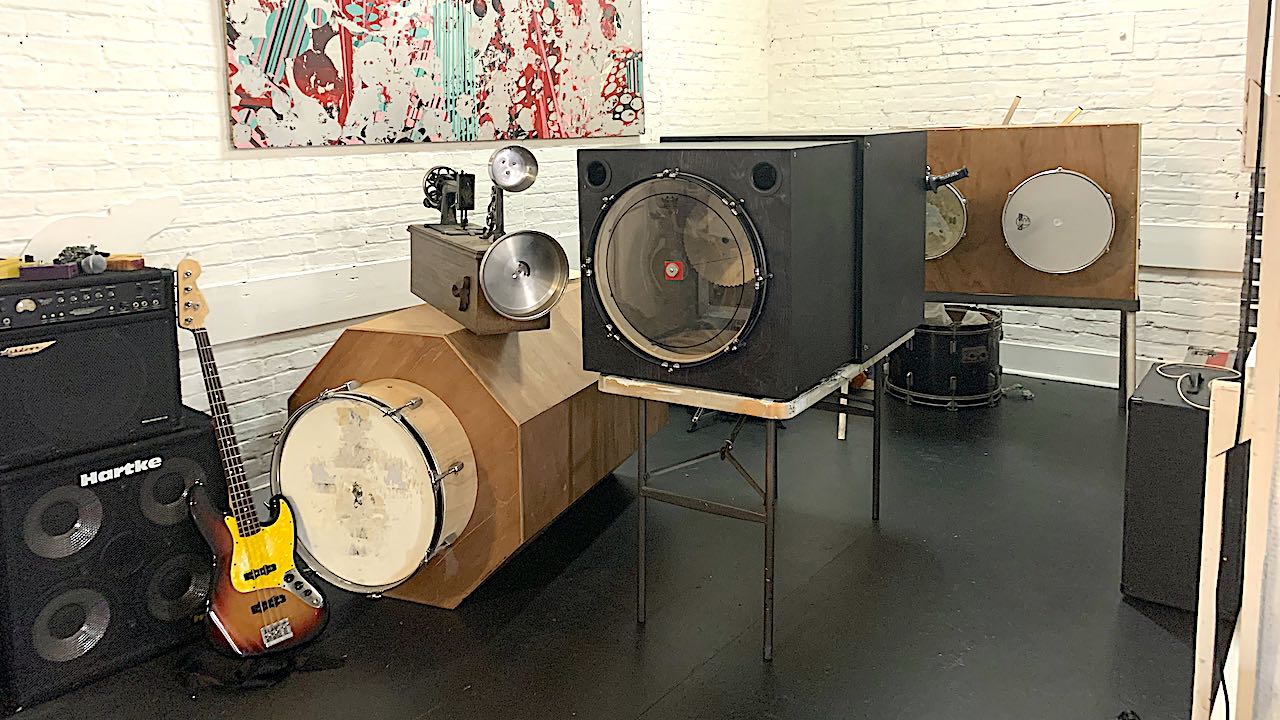mat ward : Intonarumori Building
Intonarumori Building
Exploring the musical philosphy of Italian Futurist Instrument builder Luigi Russolo (1885 - 1947) using reconstructed Intonarumori (noise intoners). Russolo believed noise should be a recognized part of contemporary composition as well as a tool for exploring the spiritual realm.

Hobart, Tasmania, Australia
I have been designing and performing with Intonarumori since being asked to curate and compose a tribute to The Futurist Instrument builder Luigi Russolo on the 100th anniversary of the publishing of his manifesto l'arte dei Rumori (the art of noises). Since 2012 I have been working on different designs and modifications to increase volume, pitch range, tone and playability. According to the small amount of written information Russolo left behind his first machines worked via the friction between a string/wire and a rotating cylinder. The string was attached to a drum head which acted as an amplifying/resonating device. The other end of the string was connected to a lever that controlled the pitch of the sound through tightening the tension. The rotating cylinders connected to a crank that turned the cylinder causing it to rub against the wire. The volume was increased by increasing the rotation of the crank. From this elementary design a vast range of different sounds could be achieved through modification of the construction materials. For instance the string/wire could be made of twine or leather or piano wire and the cylinder could be timber or metal or have indentations in it, all of which altered the sound. The Intonarumori were the weapons Russolo built to lead the attack on the music of the early 20th century as proscribed in his manifesto L’arte dei rumori. But beyond this aesthetic revolution Russolo’s motives (as always) were spiritual. He believed in the power of noise to affect human emotion and that noise could be spiritualised through mediation. He wrote in detail how an orchestra of Intonarumori could create a trance like atmosphere where the raw noise produced by the machines was manipulated via the cracks and cogs it contained to conjour energy that would further intensify the players performance resulting in the opening of portals to other realms. From here communication with spirits could unfold. Before I was aware of Russolo’s esoteric ideas I was struck by the seeming supernatural sounds of these machines, in fact they have an almost sacred quality which is what led me to in depth research of Russolo and his practice. Below are various videos, images and audio links showing where some of the research has taken me. My Intonarumori have been used as solo instruments, as part of live expanded cinema and soundtrack work, combined with more traditional and modern instruments and most recently as the foundation for a trio that explores and expands upon Russolo’s desire to open portals to other dimensions and communicate with the supernatural.
Intonarumori (noise-intoner) - a brief history
The Intonarumori are instruments designed by the Futurist artist Luigi Russolo in 1913. He built them with idea that modern music needed to reflect the sounds of the modern world, and the orchestra of the early 20th century seemed woefully behind the times having barely changed for decades. Russolo thought it lacked the timbre of industrialisation and the nuanced tonal range that could be heard in the cities of the new century. He devised a chart of noises he thought should be used to produce music that reflected the modern age and then built instruments to make the required sounds. Russolo toured his orchestra of Intonarumori through Italy, often to hostile and violent crowds, as part of the Futurists mission to overturn the existing conservative culture of Italy. He also travelled across Europe and gained particular interest in London.
All of Russolo’s original machines were destroyed or lost during WW2 and there is only one drawing showing the internal workings of one of his designs remaining. Since 2012 I have been working on different designs and modifications to increase volume, pitch range, tone and playability. According to the small amount of written information Russolo left behind his first machines worked via the friction between a string/wire and a rotating cylinder. The string was attached to a drum head which acted as an amplifying/resonating device. The other end of the string was connected to a lever that controlled the pitch of the sound through tightening the tension. The rotating cylinders connected to a crank that turned the cylinder causing it to rub against the wire. The volume was increased by increasing the rotation of the crank. From this elementary design a vast range of different sounds could be achieved through modification of the construction materials. For instance the string/wire could be made of twine or leather or piano wire and the cylinder could be timber or metal or have indentations in it, all of which altered the sound.
The Intonarumori were the weapons Russolo built to lead the attack on the music of the early 20th century as proscribed in his manifesto L’arte dei rumori. But beyond this aesthetic revolution Russolo’s motives (as always) were spiritual. He believed in the power of noise to affect human emotion and that noise could be spiritualised through mediation. He wrote in detail how an orchestra of Intonarumori could create a trance like atmosphere where the raw noise produced by the machines was manipulated via the cracks and cogs it contained to conjour energy that would further intensify the players performance resulting in the opening of portals to other realms. From here communication with spirits could unfold. Before I was aware of Russolo’s esoteric ideas I was struck by the seeming supernatural sounds of these machines, in fact they have an almost sacred quality which is what led me to in depth research of Russolo and his practice.
The Intonarumori are instruments designed by the Futurist artist Luigi Russolo in 1913. He built them with idea that modern music needed to reflect the sounds of the modern world, and the orchestra of the early 20th century seemed woefully behind the times having barely changed for decades. Russolo thought it lacked the timbre of industrialisation and the nuanced tonal range that could be heard in the cities of the new century. He devised a chart of noises he thought should be used to produce music that reflected the modern age and then built instruments to make the required sounds. Russolo toured his orchestra of Intonarumori through Italy, often to hostile and violent crowds, as part of the Futurists mission to overturn the existing conservative culture of Italy. He also travelled across Europe and gained particular interest in London.
All of Russolo’s original machines were destroyed or lost during WW2 and there is only one drawing showing the internal workings of one of his designs remaining. Since 2012 I have been working on different designs and modifications to increase volume, pitch range, tone and playability. According to the small amount of written information Russolo left behind his first machines worked via the friction between a string/wire and a rotating cylinder. The string was attached to a drum head which acted as an amplifying/resonating device. The other end of the string was connected to a lever that controlled the pitch of the sound through tightening the tension. The rotating cylinders connected to a crank that turned the cylinder causing it to rub against the wire. The volume was increased by increasing the rotation of the crank. From this elementary design a vast range of different sounds could be achieved through modification of the construction materials. For instance the string/wire could be made of twine or leather or piano wire and the cylinder could be timber or metal or have indentations in it, all of which altered the sound.
The Intonarumori were the weapons Russolo built to lead the attack on the music of the early 20th century as proscribed in his manifesto L’arte dei rumori. But beyond this aesthetic revolution Russolo’s motives (as always) were spiritual. He believed in the power of noise to affect human emotion and that noise could be spiritualised through mediation. He wrote in detail how an orchestra of Intonarumori could create a trance like atmosphere where the raw noise produced by the machines was manipulated via the cracks and cogs it contained to conjour energy that would further intensify the players performance resulting in the opening of portals to other realms. From here communication with spirits could unfold. Before I was aware of Russolo’s esoteric ideas I was struck by the seeming supernatural sounds of these machines, in fact they have an almost sacred quality which is what led me to in depth research of Russolo and his practice.
Frequently Asked Questions
What inspired you to do this?
My practice involves noise as a prime compositional building block. These machines were an important part of the history/foundation of noise music
How long did it take to make it?
Each machine took a few months, depending on what else was happening.
How long have you been doing things like this?
8 years since the first Intonarumori was build
How much did this cost to do?
Anywhere up to 1000 dollars, depending on whether parts are new or second hand and the type of materials chosen
Have you done other things like this?
Have done a lot of percussion work/writing with found objects and use field recordings of noise a lot
What did you wish you knew before you started this?
How to speak and read Italian!
Are there plans available to make this? Do you sell this?
All the original plans from the early 20th century ( except for one patent) were destroyed during the war. My machines have been constructed based on experimentation,. I haven't documented the method
What’s next?
I use the Intonarumori both as stand alone instruments, within ensembles and for film sound work. all these areas are ongoing projects depending on who is interested or what inspires me
Resoures?
Mainly writing on Luigi Russolo and networking with other people in the field. There have been many efforts to re-build the intonarumori over the last 40 years.
mat ward
: Sound Artist/Instrument Builder

Hobart, Tasmania , Australia
Mat Ward is a musician, sound artist, instrument designer and researcher who works across a wide range of genres both in acousmatic and performance settings. His recent practice examines the acoustic structure of noise; pulling apart field recordings to investigate how the properties of noise have both disruptive and cohesive elements and their relationship to human emotion and communication.
Locally and internationally he maintains a diverse collaborative practice with filmmakers, poets and musicians on projects that include free improvisation, contemporary classical music and site specific response.
His research explores the origins of experimental music with a focus on early 20th Century artists, and in particular Luigi Russolo.
Over the last decade he been awarded numerous commissions and residencies, released 15 albums and had his acousmatic work exhibited in Europe, Asia and North America.
Locally and internationally he maintains a diverse collaborative practice with filmmakers, poets and musicians on projects that include free improvisation, contemporary classical music and site specific response.
His research explores the origins of experimental music with a focus on early 20th Century artists, and in particular Luigi Russolo.
Over the last decade he been awarded numerous commissions and residencies, released 15 albums and had his acousmatic work exhibited in Europe, Asia and North America.
Connect with mat ward
Here's a shareable link to this project: https://makermusicfestival.com/projectdirectory/intonarumori-building/
The information and media presented for this project was provided by its creator. The maker owns and has copyright on all materials submitted. The maker retains all intellectual property rights, including copyright, patents, and registered designs.